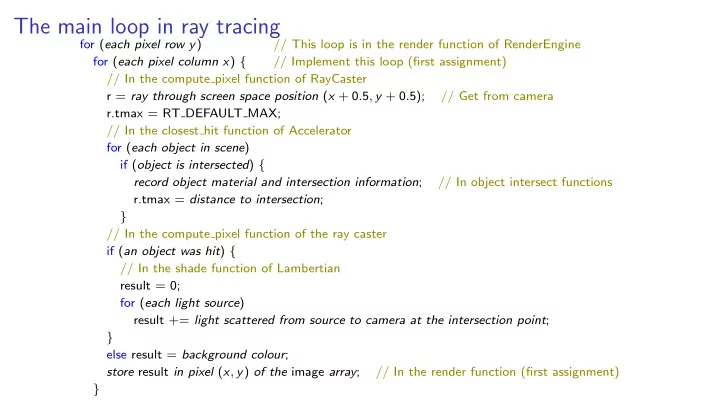

The main loop in ray tracing for ( each pixel row y ) // This loop is in the render function of RenderEngine for ( each pixel column x ) { // Implement this loop (first assignment) // In the compute pixel function of RayCaster r = ray through screen space position ( x + 0 . 5 , y + 0 . 5); // Get from camera r.tmax = RT DEFAULT MAX; // In the closest hit function of Accelerator for ( each object in scene ) if ( object is intersected ) { record object material and intersection information ; // In object intersect functions r.tmax = distance to intersection ; } // In the compute pixel function of the ray caster if ( an object was hit ) { // In the shade function of Lambertian result = 0; for ( each light source ) result += light scattered from source to camera at the intersection point ; } else result = background colour ; store result in pixel ( x , y ) of the image array ; // In the render function (first assignment) }
Shading pixels (local illumination) // Starting in Lambertian.cpp with a ray that hit a surface for ( each light source ) { construct a variable for accumulating light from this source ; for ( each light source sample ) { // Handle the following three lines by calling the function sample(. . . ) // associated with the light source. if ( ray from surface position to sample point is not occluded ) { get the direction toward the sample point on the light ; compute the amount of radiance incident from the sample point ; if ( cosine of angle between surface normal and direction is positive ) accumulate incident light multiplied by cosine term ; } } add accumulated light divided by number of samples to final result ; } multiply final result by diffuse reflectance and add emission ;
Lambert’s cosine law brightness decreases in the same ratio by which the sine of the angle of incidence decreases [Lambert 1760] ◮ Lambert uses the angle ( CAF = DBF ) between the direction of the rays ( CA and DB ) and the surface tangent plane ( AB ) as the angle of incidence. ◮ If we instead measure the angle of incidence θ from the normalised surface normal ω ′ , sine becomes cosine. n to the direction toward the incident light � � ◮ Then the diffusely reflected light is L r = ρ d π L i cos θ = ρ d ω ′ ) . π L i ( � n · � where ρ d is the diffuse reflectance.
Recommend
More recommend